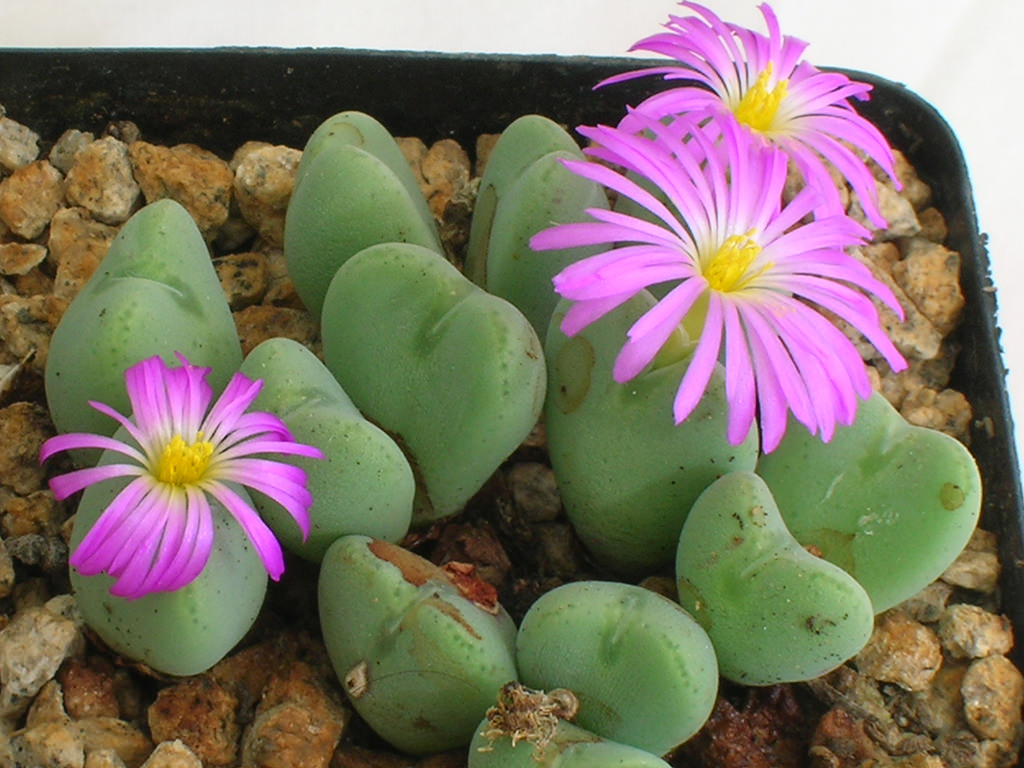Scientific Name
Conophytum cordatum Schick & Tisch.
Accepted Scientific Name
Conophytum bilobum (Marloth) N.E.Br.
Common Name(s)
Living Pebble
Scientific Classification
Family: Aizoaceae
Subfamily: Ruschioideae
Tribe: Ruschieae
Genus: Conophytum
Origin
This succulent is a form of Conophytum bilobum subsp. bilobum with violet or magenta flowers. It is native to the western part of South Africa.
Description
Conophytum cordatum is a small succulent with short internodes and bodies of two thick, fleshy, partly fused leaves. It produces many bodies densely clustered in a small mound. The bodies are heart-shaped to rabbit-eared in side view, with keeled or rounded apices, up to 2.8 inches (7 cm) tall, and up to 1.2 inches (3 cm) wide. The epidermis is spotted or smooth, and its color varies from yellowish-green, grayish-green, blue-green to pinkish or reddish. Flowers are scentless, up to 1.2 inches (3 cm) in diameter, white to light violet at the base, and violet or magenta toward the tips. They are diurnal and usually appear in the fall.
C. cordatum is very similar in appearance to Conophytum velutinum.
Etymology
The specific epithet "cordatum" derives from the Latin adjective "cordatus," meaning "heart-shaped or cordate," and refers to the shape of the body.

How to Grow and Care for Conophytum cordatum
Light: This succulent needs bright light but does not like too much direct sun. To avoid sunburn, place your C. cordatum in a position to receive a few hours of full sun in cooler periods of the day. The plant stretch if it needs more light.
Soil: C. cordatum thrives best in porous soil mixes that allow water to drains away quickly. Use a commercial potting mix specially designed for growing succulents or make your own.
Hardiness: High temperatures are not a problem for this plant, but it can be damaged when the temperature goes below freezing. C. cordatum can withstand temperatures as low as 30 to 50 °F (-1.1 to 10 °C), USDA hardiness zones 10a to 11b.
Watering: When it goes dormant in the spring, C. cordatum requires little or no water. In the fall, when it will begin growing, it is safe to water deeply, allowing the soil to dry before watering again. During active growth, if leaves start to wrinkle, your plant needs water.
Fertilizing: This small succulent is a light feeder and does not need fertilizer if it is repotted every two years.
Repotting: The best time to repot C. cordatum is at the beginning of the period of active growth, but repotting can be done at almost any time while the plant is actively growing.
Propagation: Like all Conophytums, this plant is easily propagated by division. It can also be grown from seeds. The best time to divide C. cordatum is in late summer or early fall, before it begins to break dormancy, or after it has flowered. Sow the seeds in fall in a pot with a well-drained soil mix.
Learn more at How to Grow and Care for Conophytum.
Toxicity of Conophytum cordatum
C. cordatum is non-toxic and safe to grow around children and pets.
Links
- Back to genus Conophytum
- Succupedia: Browse succulents by Scientific Name, Common Name, Genus, Family, USDA Hardiness Zone, Origin, or cacti by Genus
Photo Gallery
Click on a photo to see a larger version.



